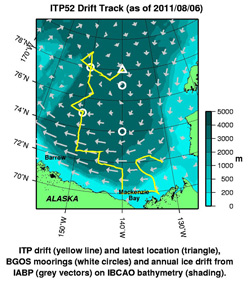Please note: You are viewing
the unstyled version of this website. Either your browser does not support CSS
(cascading style sheets) or it has been disabled. Skip
navigation.
Dr. Mary-Louise TimmermansAugust 5, 2011Helicopter Pilot Chris Swannell, Ice Observer Roger Provost, Rick Krishfield and Steve Lambert needed only a short reconnaissance flight to find a floe about 1 km from the ship for the deployment of our first Ice Based Observatory (IBO). We’ll deploy two more IBOs (multiple instrument systems on a single ice floe) on this cruise. The floe was roughly 200 m by 75 m – large enough to deploy multiple ice buoys, take more ice-core samples, and perform an electromagnetic survey to obtain sea-ice thickness. Similar to yesterday, Captain McNeill maneuvered the ship to be about 400 m away from the floe for safety and easy transport. Several holes needed to be augered on the floe for the placement of multiple buoys. It soon became clear that the floe thickness was quite variable, between about 2 and 5 meters thick, with thickness changing by more than 1 meter over a lateral distance of only a few meters. A more uniform floe is preferable for these deployments, but the search was hindered by fog today, and choices were limited. Drill sites indicated voids (up to 2 meters thick) beneath the top layer of ice that are filled with seawater and likely caused by converging and colliding floes (rafting and ridging) that can stack on top of each other. The ITP team and Carpenter Gary Morgan deployed ITP 52 (an ITP with sensors to measure chlorophyll fluorescence and other bio-optical properties, and a dissolved oxygen sensor in addition to temperature and salinity sensors) on a 4-m thick region of ice. Mike Dempsey (IOS) and Steve Lambert (WHOI) deployed an Ice Mass Balance (IMB) buoy about 20 meters away from the ITP site where the ice was a little less than 2 m thick. The IMB buoys, developed at the US Army Cold Regions Research and Engineering Laboratory in Hanover, NH, measure surface air temperature and pressure, snow depth, ice thickness and temperature, and temperature of the ocean just beneath the base of the ice. While the other buoys were being deployed, Carlton Rauschenberg (Bigelow Laboratory for Ocean Sciences, Maine) and Wes Halfacre (Purdue University, Indiana) installed a significantly larger buoy – the O-buoy, which measures the chemistry of the Arctic atmosphere. Carlton and Wes will write a separate dispatch on this project. The O’buoy required a larger 16” hole, while the others on the floe could be deployed through 11” holes. For the larger hole, WHOI’s new substantial trenching auger was slung by helicopter from the ship. This is the first time the team has used the commercially available auger (it’s called the “Little Beaver”) and John Kemp was impressed by the ease of set up and operation. We’ll now steam southeast (with more CTD/Rosette casts and plankton net tows along the way) in search of another large floe for the next IBO deployment. The National Snow and Ice Data Center (http://www.nsidc.org/) reports that the amount of old (older than 5 years), thick ice in the Arctic is declining. In this part of the Beaufort Sea, with a little more than a month before the end of the melt season, the ice appears to have melted back to the edge of the multi-year pack that is older than one year. Last updated: October 7, 2019 | ||||||||||||||||||||
Copyright ©2007 Woods Hole Oceanographic Institution, All Rights Reserved, Privacy Policy. | ||||||||||||||||||||



